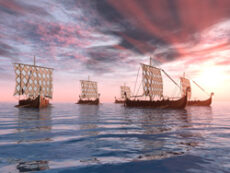The Viking Longships
 In medieval Norway the basis for agriculture was poor. Vikings were experts in water transportation as their native fjords stretched for great distances into Norway’s heartland. The Vikings built fast ships for raiding and war. These ships were ‘dragon-ships’ or ‘longships’. Vikings longships were narrow, light, wooden boats with a shallow-draft hull designed for speed and easy navigation in shallow waters. Light enough to be carried, Vikings longships was also double-ended, allowing it to reverse direction without needing to turn around. This was a major advantage in a sea filled with concealed icebergs and sea ice. Viking longships could sail in shallow water. So they could travel up rivers as well as across the sea. In a raid, a ship could be hauled up on a beach. The Vikings could jump out and start fighting, and then make a quick getaway if they were chased.Vikings longships had oars along almost the entire length of the boat, and later versions combined rowing power with sailing power. In good conditions, a Vikings longships under sailing power could reach a speed of 15 knots.
In medieval Norway the basis for agriculture was poor. Vikings were experts in water transportation as their native fjords stretched for great distances into Norway’s heartland. The Vikings built fast ships for raiding and war. These ships were ‘dragon-ships’ or ‘longships’. Vikings longships were narrow, light, wooden boats with a shallow-draft hull designed for speed and easy navigation in shallow waters. Light enough to be carried, Vikings longships was also double-ended, allowing it to reverse direction without needing to turn around. This was a major advantage in a sea filled with concealed icebergs and sea ice. Viking longships could sail in shallow water. So they could travel up rivers as well as across the sea. In a raid, a ship could be hauled up on a beach. The Vikings could jump out and start fighting, and then make a quick getaway if they were chased.Vikings longships had oars along almost the entire length of the boat, and later versions combined rowing power with sailing power. In good conditions, a Vikings longships under sailing power could reach a speed of 15 knots.
This resulted in voyages of discovery, trade and opportunistic raiding of coastal cities, towns and settlements across Europe. The voyages began in the latter part of the eighth century and stretched from Greenland in the west to the Caspian Sea in the east. To begin with only a few made the voyages, but the fleets grew until there were hundreds of Vikings longships sailing to England, Scotland, France and Ireland.